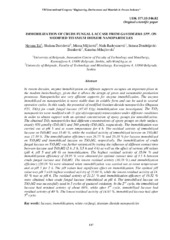Prikaz osnovnih podataka o dokumentu
IMMOBILIZATION OF CRUDE FUNGAL LACCASE FROM GANODERMA SPP. ON MODIFIED TITANIUM DIOXIDE NANOPARTICLES
| dc.creator | Ilić, Nevena | |
| dc.creator | Davidović, Slađana | |
| dc.creator | Miljković, Miona | |
| dc.creator | Radovanović, Neda | |
| dc.creator | Dimitrijević-Branković, Suzana | |
| dc.creator | Mihajlovski, Katarina | |
| dc.date.accessioned | 2023-12-12T09:41:37Z | |
| dc.date.available | 2023-12-12T09:41:37Z | |
| dc.date.issued | 2023 | |
| dc.identifier.isbn | 978-99955-81-45-9 | |
| dc.identifier.uri | http://TechnoRep.tmf.bg.ac.rs/handle/123456789/6943 | |
| dc.description.abstract | In recent decades, enzyme immobilization on different supports occupies an important place in the modern biotechnology, given that it allows the design of green and sustainable production processes. Nanoparticles are very efficient supports for enzyme immobilization. The enzyme immobilized on nanoparticles is more stable than its soluble form and can be used in several operative cycles. In this study, the potential of modified titanium dioxide nanoparticles (Degussa P25, TiO2) for crude fungal laccase (47.43 U/g) immobilization was investigated. The TiO2 nanoparticles were modified with (3-glycidyloxypropyl) trimetoxylane under different conditions in order to obtain support with an optimal concentration of epoxy groups for immobilization. The obtained TiO2 nanoparticles had different concentrations of epoxy groups on their surface, exactly 950 μmol/g (TiO2M1) and 500 μmol/g (TiO2M2), respectively. The immobilization was carried out at pH 5 and at room temperature for 4 h. The residual activity of immobilized laccase on TiO2M2 was 33.40 %, while the residual activity of immobilized laccase on TiO2M1 was 17.39 %. The immobilization efficiency was 26.75 % and 20.18 % for laccase immobilized on TiO2M2 and immobilized laccase on TiO2M1, respectively. The immobilization of crude fungal laccase on TiO2M2 was further optimized by testing the influence of different contact time between laccase and TiO2M2 (2 h ,3 h, 3,5 h and 4 h) as well as the effect of various pH values (pH 4, pH 5 and pH 6) on immobilization. The highest residual activity of 35.04 % and immobilization efficiency of 28.95 % were obtained for optimal contact time of 3.5 h between crude fungal laccase and TiO2M2. The lowest residual activity (30.38 %) and immobilization efficiency (20.18 %) were obtained when immobilization was carried out at room temperature and at pH 5 for 2 h. The pH values had significant effect on immobilization. The optimal pH value was pH 5 with highest residual activity of 35.04 %, while the lowest residual activity of 14. 83 % was at pH 6. The residual activity of 21.21 % and immobilization efficency of 19.52 % were obtained when crude fungal laccase immobilized at pH 4. The immobilized laccase on TiO2M2 was successfully used in 5 cycles of guaiacol oxidation. In the 2nd cycle, the immobilized laccase had residual activity of about 60%, while after 3rd cycle, immobilized laccase had residual activity of 40 %. The lowest residual activity of 14.83 %, immobilized laccase had after 5th cycle. | sr |
| dc.language.iso | en | sr |
| dc.publisher | Zvornik : University of East Sarajevo Faculty of Technology | sr |
| dc.relation | info:eu-repo/grantAgreement/MESTD/inst-2020/200135/RS// | sr |
| dc.relation | info:eu-repo/grantAgreement/MESTD/inst-2020/200287/RS// | sr |
| dc.rights | openAccess | sr |
| dc.rights.uri | https://creativecommons.org/licenses/by/4.0/ | |
| dc.source | Proceedings / VIII International Congress "Engineering, Environment and Materials in Process Industry", EEM2023, Jahorina, March 20-23, 2023 | sr |
| dc.subject | laccase | sr |
| dc.subject | immobilization | sr |
| dc.subject | white rot fungi | sr |
| dc.subject | titanium dioxide nanoparticles | sr |
| dc.title | IMMOBILIZATION OF CRUDE FUNGAL LACCASE FROM GANODERMA SPP. ON MODIFIED TITANIUM DIOXIDE NANOPARTICLES | sr |
| dc.type | conferenceObject | sr |
| dc.rights.license | BY | sr |
| dc.citation.epage | 196 | |
| dc.citation.spage | 187 | |
| dc.identifier.fulltext | http://TechnoRep.tmf.bg.ac.rs/bitstream/id/18977/Manuscript.pdf | |
| dc.identifier.rcub | https://hdl.handle.net/21.15107/rcub_technorep_6943 | |
| dc.type.version | publishedVersion | sr |

